Things to see on Everest Base Camp Trek
The trek to Everest Base Camp (EBC) is one of the most popular and iconic trekking routes in the world. Thousand of adventure lovers seek to go to Mount Everest Base Camp Trek and want to know what can be seen on the way, and what travelers can experience on the trek. It offers an opportunity to explore the Khumbu region of Nepal, home to the highest mountain in the world, Mount Everest, and the Sherpa people who have lived in the region for generations.
The trek is a challenging but rewarding experience that offers once-in-a-lifetime views of the mountain, as well as an opportunity to immerse yourself in the culture and lifestyle of the Sherpa people. Trekking to the base of Mount Everest, the highest peak in the world, is a must-do for any adventurous traveler.
Certain places along the trek to Everest Base Camp (EBC) are considered particularly significant or noteworthy. These places are thought to offer experiences that are unique and memorable, and that cannot be found anywhere else on the trek. They are also expected to enhance the overall trekking experience, making it more enjoyable and meaningful.
Here are a few significant places not to miss on the EBC Trek journey.

Sherpa Villages
Trekking in the Everest region is not only about the physical challenge of climbing in the mountains, but also about immersing oneself in the fascinating culture and lifestyle of the Sherpa people and gaining a deeper understanding of their way of life.
The Everest region is the home of the Sherpa people, an ethnic group known for their skills in mountain climbing and their deep connection to the Himalayas. The Sherpas are renowned for their skills and expertise as mountaineers, and you will see them at work as they help to guide and support trekkers and climbers on their journeys to the summit of Mount Everest. The region is dotted with beautiful Sherpa villages, many of which are located along the trail to Everest Base Camp (EBC).
These villages offer a glimpse into the traditional way of life of the Sherpa people and provide an opportunity to learn about their culture, customs, and traditions.
1. Lukla Village
Lukla is a village located in the Solukhumbu District of Nepal. It is situated at an altitude of 2,860 meters (9,383 feet) and is the starting point for many trekkers and climbers heading to Mount Everest. The Sherpa ethnic group resides in Lukla and is well-known for its mountaineering prowess and close ties to the Himalayan highlands.
Lukla village is not only the starting point for many trekkers and climbers heading to Mount Everest, but it is also a traditional Sherpa village. The Sherpa people, who are known for their mountaineering skills, play a crucial role in the local economy and offer their hospitality to visitors. The village is a popular destination for trekkers and climbers, who come to experience the unique culture and hospitality of the Sherpa people while respecting their way of life.

2. Phakding Village
A tiny Sherpa community after Lukla called Phakding Village is located in Nepal's Everest Base Camp Trek route. It is located on the bank of Dudh Koshi River Valley in the Solukhumbu District at a height of 2610 m (or around 8562 ft).
Gompas, or traditional Sherpa monasteries, are significant sites of prayer for the Sherpa people and are abundant throughout the area.

These gompas provide a look into the rich cultural legacy of the Sherpa people and are decorated with vibrant prayer flags and artistic woodwork. The gompas are open to visitors who want to learn more about Sherpa customs and culture.
3. Manjo Village
Monjo is a small Sherpa village located in the Solukhumbu District of Nepal. It is situated at an altitude of 2,835 meters (9,301 feet) and is a popular stop for trekkers and climbers heading to Mount Everest. Monjo village is also located on the banks of the Dudh Koshi River, and it is surrounded by lush forests and beautiful mountain scenery.
Monjo is a popular stop for trekkers and climbers to spend the night on the way to Mount Everest Base Camp, as it is located on the trail between the villages of Lukla and Namche Bazaar.
Along the trek, trekkers and climbers are greeted by the friendly and welcoming Sherpa people, who offer them a warm bed and a hot meal. The Sherpa people also offer guidance and advice on how to navigate the mountains safely.
Namche Bazaar Namche Bazaar is a small town located in the Solukhumbu District of Nepal, in the Khumbu region. It is situated at an altitude of 3,440 meters (11,286 feet) and is a popular stop for trekkers and climbers heading to Mount Everest.
4. Namche Bazaar
Namche Bazar is often referred to as the "Gateway to Mount Everest" and is the main trading center of the Khumbu region. Mount Everest, Mount Lhotse, and Mount Ama Dablam are among the breathtaking mountain peaks that surround the town. Additionally, it is situated alongside the Dudh Koshi River, which flows through the town. Many Sherpas, who are renowned for their climbing prowess and close ties to the Himalayan mountains, live in the town, which blends traditional and contemporary infrastructure.
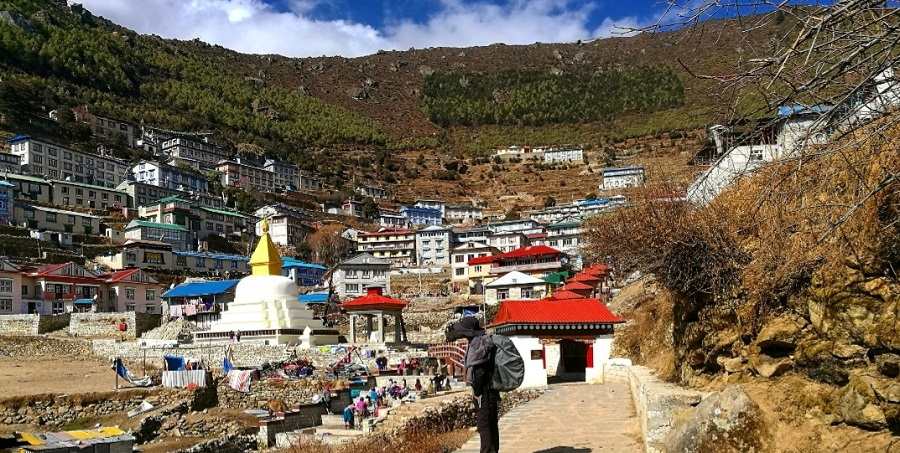
5. Pangboche Village
Pangboche is a traditional Sherpa village located in the Solukhumbu District of Nepal, known for its picturesque setting surrounded by lush green forests and towering peaks. The village is home to many Sherpa people, who play a crucial role in the local economy and offer their hospitality to visitors.
It is also a popular stop for trekkers and climbers on the way to Mount Everest Base Camp and it is also home to many traditional Sherpa monasteries, including the oldest one in the Khumbu region. Visitors can experience the unique culture and hospitality of the Sherpa people while respecting their way of life.
6. Dingboche Village
The Solukhumbu District of Nepal is home to the historic Sherpa settlement of Dingboche, which is renowned for its breathtaking location amidst the Ama Dablam, Lhotse, and Island peak peaks. Many Sherpa people, who are renowned for their climbing prowess and close ties to the Himalayas, reside in the area.
They are renowned for their fortitude, resiliency, and hospitality and have adapted to the challenging circumstances of high altitude. The Sherpa people are essential to the local economy since they work as tour guides and manage hotels and lodges for tourists.
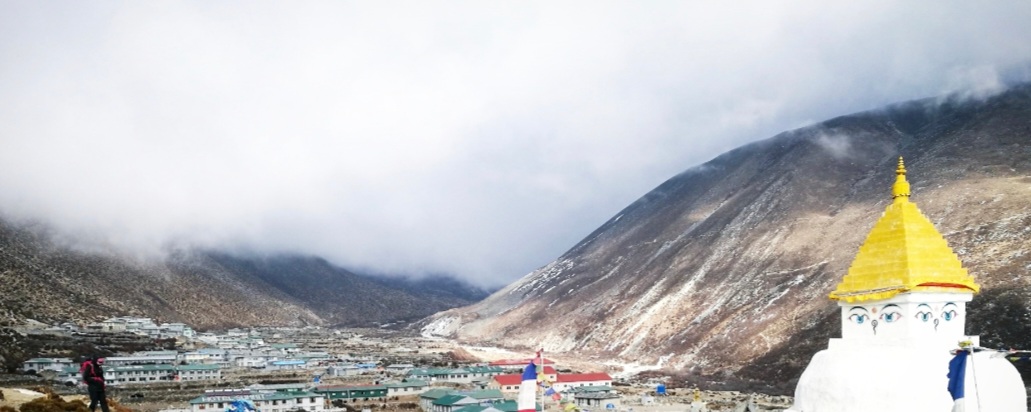
Monasteries Buddhist
One of the most revered paths in the Khumbu region is the Meditational Trek to Buddhist Sacred Sites, which offers a wide variety of monasteries, Chortens, and hermitages for meditation. This Khumbu area holy sites walk is less used by trekkers and was created specifically for individuals looking for peace to relieve tension with a spiritual touch of historic Buddhist sacred monasteries, caves, and hermitages.
The hike allows you to explore and feel the tranquil splendor of the high Himalayas while wandering in nature, rather than only focusing on meditation. Trekkers get the chance to explore the distinctive spiritual and cultural history of the Sherpa people, who are well-known for their close ties to the Himalayan mountains, at the monasteries in the Khumbu region.
Numerous of these monasteries include fine carvings and vibrant prayer flags, and they provide a window into the Sherpa people's extensive spiritual traditions. Visitors are welcome to explore the monasteries, take part in meditation and other spiritual activities, and learn more about the traditions.
1. Phakding Monastery
Phakding Monastery is located in the Solukhumbu district of Nepal. It's an active Buddhist Monastery that has recently been expanded. The Monastery offers a beautiful view of the surrounding mountains, including Thamserku, Kusum Kanguru, and Tawache. Some people say that Mount Everest can be seen from the higher parts of the ridge.
Inside the main hall of the Monastery, there is a statue of Guru Rinpoche, a religious figure in Buddhism, holding a Vajra/Dorje, a mace of skulls and vase-like objects. On either side of the statue, there are two female deities known as Yeshe Tsogyal and Mandarava. The Monastery is home to around 20 monks and nuns who perform traditional rituals and puja, usually in the mornings. Visitors can go upstairs to see prayer books and a mask of the long-life man Mi Tsering, with permission from the abbot.
The courtyard is used for celebrations of festivals such as the yearly Dumje puja, and it helps to refocus and reawaken the old traditions and festivals of the Sherpa culture. Visitors can also see some old silk and wood-painted panels which display three images, one of Tsong Khapa, the founder of the later Gelug-pa sect of the Dalai Lama, one of the Sakyamuni Buddha, and one astonishing Yab-Yum figure which is particularly interesting as it represents the fearsome version with the ugly three-headed male demon embracing his consort and standing on corpses. The monks and nuns here were preparing and taking their traditional breakfast of tsampa balls and butter tea.
2. Tengboche Monastery
Tengboche Monastery is a revered historical and spiritual site that can be found in Nepal's Solukhumbu region along the hike to Mount Everest Base Camp. Chatang Chotar, also known as Lama Gulu, founded the first monastery in 1916. The monastery has links to the Rongbuk Monastery, which is close to Mount Everest's base camp on the Tibetan side.
The monastery was devastated by an earthquake in 1934, and Lama Gulu died soon after. In 1989, a terrible fire destroyed the monastery and destroyed some of its valuables. The newly constructed monastery has been completely restored. Ngawang Tenzin Jangpo, the current Rinpoche, was born on the same day as the Dalai Lama in 1935. He was identified as the reincarnation of Lama Gulu during a family visit to the Rongbuk monastery. In 1956, he visited Tengboche again after completing his basic training in Tibet. He is presently actively advocating Buddhism and environmental protection.
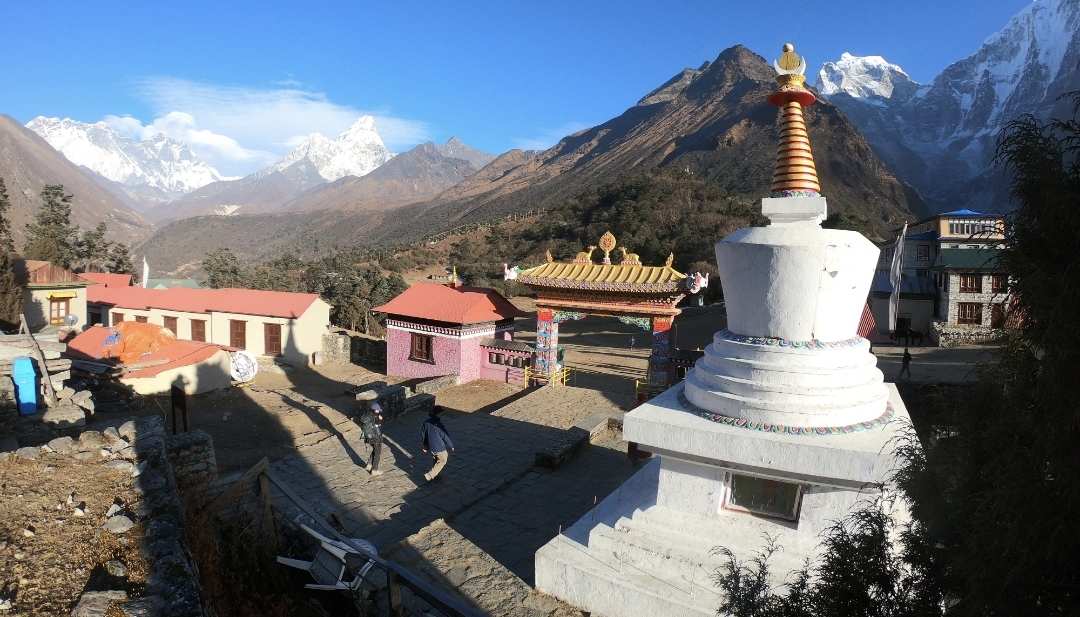
3. Pangboche Monastery
Pangboche Monastery is a Tibetan Buddhist monastery located in the Pangboche village of the Solukhumbu District in Nepal. It is one of the oldest and highest monasteries in the region and is particularly known for its ancient statue of the Amitabha Buddha, which is said to be the oldest surviving statue of its kind in the region.
The monastery is also known for its association with the Yeti, as a supposed Yeti scalp is kept in the monastery as a sacred relic. Pangboche Monastery is a popular destination for trekkers and mountaineers visiting the Everest region.
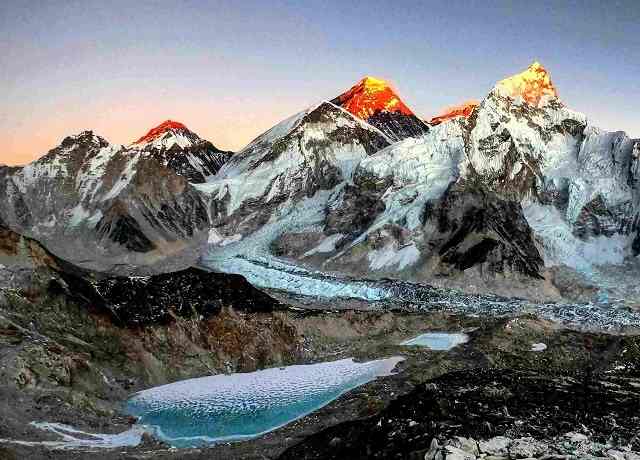 popular
popular
Everest Base Camp Trek 14 days | EBC Trekking
$ 1350.0 $ 1100.0
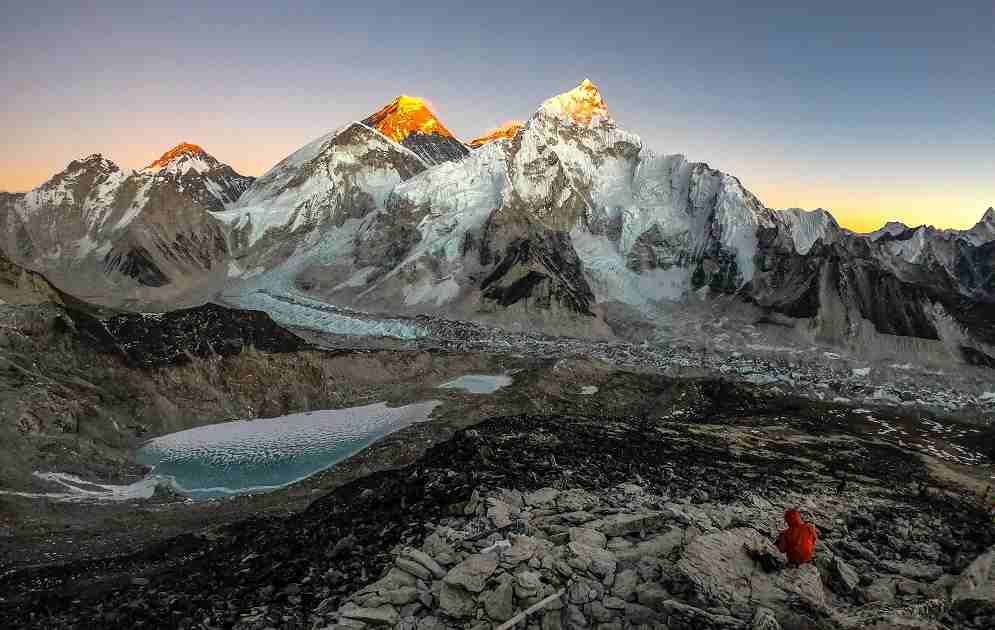
Everest Base Camp Trek 15 Days
$ 1650.0 $ 1300.0
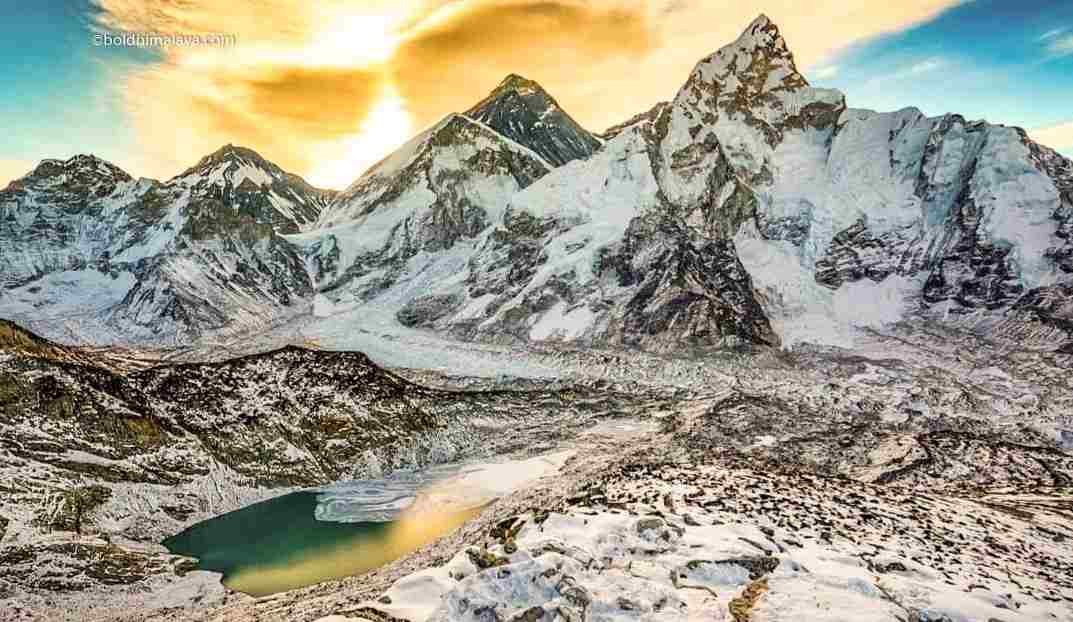
Everest Base Camp Trek 16 days Guided Hiking Tour
Price on request
Airports
The Solukhumbu region of Nepal, also known as the Everest region, is a popular destination for trekkers and mountaineers from around the world. The region is home to several airports that serve as the main point of entry for visitors to the area, as well as for locals and tourists. The Syangboche Airport, Tenzing-Hillary Airport (also known as Lukla Airport), and Phaplu Airport are the major airports of the region.
1. Lukla Airport
Lukla airport is the primary airport serving the region and is located in the town of Lukla. It is considered one of the most dangerous airports in the world due to its short runway and challenging approach. The airport was named after Sir Edmund Hillary and Tenzing Norgay, the first climbers to summit Mount Everest. The airport is served by several domestic airlines and is the starting point for most trekking routes to the Everest region.

2. Syangboche Airport
This airport is located in the small village of Syangboche, which is near Namche Bazaar, the major town in the region. The airport is not served by regular commercial flights and it is mainly used by private and charter flights. The runway of Syangboche airport is too short and not suitable for big commercial aircraft. Visitors can take a flight to this airport and then trek to nearby Namche Bazaar, the major town in the region, which is also the starting point of most trekking routes to the Everest region.
Museum
The Solukhumbu district of Nepal, located in the foothills of the Himalayas, is not known for having many museums. However, there are a few cultural and historical sites that you may find of interest. These museums provide insight into the rich culture and history of the region, which is known for its famous trekking routes and the highest peak in the world, Mount Everest.
You can learn about the indigenous Sherpa people, their culture and lifestyle, and their connection to the mountain, through artifacts, clothing, tools, and equipment used in their daily lives. You can also learn about the life and achievements of Sir Edmund Hillary and other climbers who have summited Mount Everest.
Additionally, You can also learn about the Tibetan Buddhism culture and their religious practices and beliefs by visiting monasteries like Pangboche Monastery. Though the museums may be small and have limited resources, they are a great way to immerse yourself in the culture and history of the region.
1. Sherpa Culture Museum
The Sherpa Culture Museum, located in the town of Namche Bazaar in the Solukhumbu district of Nepal, provides an in-depth look into the culture and lifestyle of the Sherpa people, who are the indigenous inhabitants of the region. The museum was established in 2003 to preserve the traditional culture and heritage of the Sherpa people and to educate visitors about their way of life.
The museum displays a wide range of traditional artifacts, clothing, tools, and equipment used by the Sherpas in their daily lives. Visitors can see traditional Sherpa clothing, such as traditional Tibetan clothes, which are adorned with intricate designs and patterns. Visitors can also see tools and equipment used for agriculture, such as plows and sickles, as well as tools used for hunting and fishing.
Visitors can also learn about the traditional architecture of Sherpa homes and the various customs and rituals associated with Sherpa culture. The museum also has a section dedicated to the history of mountaineering in the region, with photographs and artifacts from the first ascent of Mount Everest, which was completed by Sir Edmund Hillary and Tenzing Norgay in 1953.
In addition to the exhibits, the museum also offers cultural programs and performances, such as traditional music and dance performances, which give visitors a taste of Sherpa culture and provide a deeper understanding of the region's history and heritage. The Sherpa Culture Museum is a great way for visitors to gain a deeper understanding and appreciation of the culture and heritage of the Sherpa people, who are an integral part of the history and culture of the Solukhumbu region.
2. Sagarmatha National Park Museum
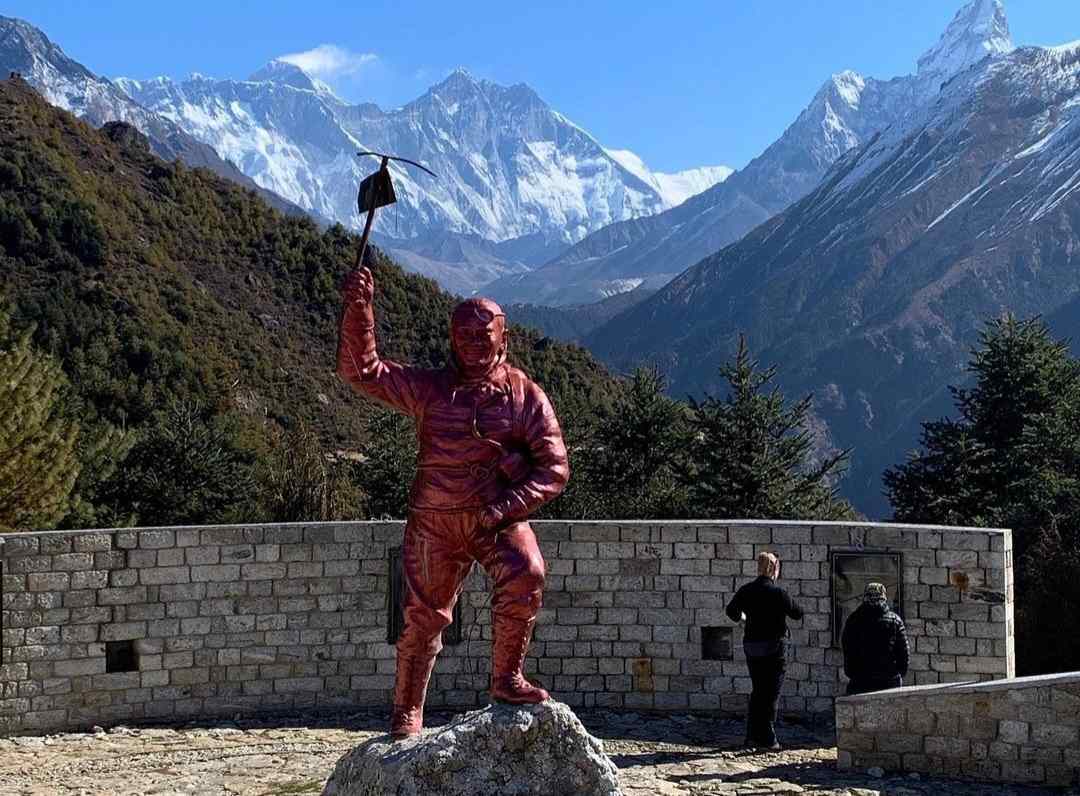
Sagarmatha National Park Museum is a museum located in the Sagarmatha National Park, in the Solukhumbu district of Nepal. The museum is dedicated to the natural and cultural heritage of the Sagarmatha National Park and the surrounding region, which is home to Mount Everest, the highest peak in the world. The park is also a UNESCO World Heritage Site.
The museum showcases the unique flora and fauna, geology and geography, and the history and culture of the region through interactive exhibits and displays. Visitors can see the different species of plants and animals found in the park, such as the Himalayan tahr, the snow leopard, and the red panda. They can also learn about the different cultures of the people living in the park, such as Sherpa, Rais, and Bhutias.
The museum also has a section dedicated to the history of mountaineering in the region, which includes photographs, equipment, and artifacts from the first ascent of Mount Everest, which was completed by Sir Edmund Hillary and Tenzing Norgay in 1953. The museum also has an auditorium where visitors can watch documentaries about the park and its history, culture, and wildlife.
Sagarmatha National Park Museum is a great way for visitors to learn about the natural and cultural heritage of the Sagarmatha National Park and the surrounding region, and gain a deeper understanding of the history and culture of the Solukhumbu district.
Stunning View Points
Mount Everest, the highest peak in the world, is a natural wonder that attracts thousands of visitors each year. The mountain offers several viewpoints from where visitors can admire its grandeur and take in its breathtaking beauty.
Some of the most popular viewpoints for viewing Mount Everest are:
1. Kala Patthar
Kala Patthar is a peak located at an altitude of 5,643 meters (18,513 feet) above sea level, in the Solukhumbu district of Nepal. It is a popular viewpoint for trekkers and mountaineers who are visiting the Everest Base Camp. The peak offers a panoramic view of Mount Everest and the surrounding landscape, including other peaks such as Lhotse, Nuptse, and Ama Dablam.
Reaching Kala Patthar is a challenging but rewarding experience, as it is typically reached as a side trip from the traditional Everest Base Camp trek. The trek to Kala Patthar starts from Lukla, and it takes several days to reach the peak. The trail passes through several Sherpa villages, such as Namche Bazaar, Tengboche, and Gorak Shep, and it provides an opportunity to experience the culture and lifestyle of the Sherpa people. Once at the top of Kala Patthar, visitors can enjoy the spectacular views of Mount Everest and the surrounding peaks.
It's considered one of the best places to take photographs of Mount Everest, as the view of the mountain from the summit is unobstructed and the lighting is often ideal for photography. It's worth noting that trekking to Kala Patthar requires proper acclimatization, physical fitness, and the right gear, as the peak is located at a high altitude and the weather can be unpredictable. Visitors should also be prepared for cold temperatures and potential altitude sickness.

2. Nangkartshang Peak Viewpoint
Nangkartshang is situated at 5150m/16896ft at the top of Dingboche Village. It is not a significant peak to climb, but it is a well-liked vantage point for people who desire to take in the beauty of Mount Everest and the surrounding area. Located at an altitude of 7,045 meters (23,130 feet) above sea level, Nangkartshang offers a panoramic view of Mount Everest and the surrounding peaks, such as Lhotse, Nuptse, and Ama Dablam.
The viewpoint is considered one of the best places to take photographs of Mount Everest, as the view of the mountain from the peak is unobstructed and the lighting is often ideal for photography. Nangkartshang viewpoint is often accessed via a detour from the standard Everest Base Camp hike, making it a difficult yet rewarding experience.
Starting from Namche Bazaar, the journey to Nangkartshang viewpoint takes many days to complete. The path offers a chance to learn about Sherpa culture and lifestyle as it goes through various Sherpa communities, including Tengboche.
It should be observed that trekking to the Nangkartshang viewpoint requires appropriate acclimatization, physical fitness, and the appropriate equipment due to the viewpoint's high altitude and variable weather. Additionally, visitors should be prepared for the chilly weather and possible altitude sickness. Even if it's not as difficult as climbing Mount Everest, the walk is nonetheless difficult.

3. Kshum Khangru Peak View Point
Kusum Kanguru Peak is a mountain located in Kusum Kanguru Peak, Nepal, with a summit at an altitude of 6,367 meters. It offers a panoramic view of some of the world's highest peaks, including Mount Everest, Lhotse, Makalu, Cho Oyu, Nuptse, Thamserku, and the majestic Ama Dablam, as well as many other surrounding high peaks.
This peak climbing adventure is not only about reaching the summit but also an opportunity to explore the authentic Sherpa culture and experience their way of living amid the Himalayas.
Kusum Kanguru is a Tibetan name that translates to "Three Snow Peaks." The peak climbing of Kusum Kanguru is an ideal option for those seeking an unlimited climbing adventure up to a high peak. The climb includes a scenic flight from Kathmandu to Lukla and back, giving you a chance to admire the beautiful landscapes of Nepal.
4. Everest View Point
Near the foot of Mount Everest, in the Solukhumbu region, lies a viewpoint known as Everest View Point. It is a well-liked location for tourists to the area to take in the magnificence of Mount Everest and the surrounding scenery.
At around 3,867 meters (12,687 ft) above sea level, the viewpoint provides a wide-angle picture of Mount Everest, including the South Col, Southeast Ridge, and South Summit.
Since there are no obstructions in the view of the mountain from the summit and the lighting is frequently favorable for photography, the viewpoint is regarded as one of the greatest sites to shoot pictures of Mount Everest.
Mountains Above 8000m
Mount Everest, Lhotse, Makalu, and Cho Oyu are a few of the 8,000-meter mountains situated in Nepal's Solukhumbu region. Mount Everest is the highest mountain on the planet, these peaks are regarded as some of the most arduous climbs in the whole world.
These summits demand the correct equipment, enough physical preparation, and acclimatization. Since the peaks are situated at a high elevation, the weather may be erratic and harsh.
1. Mount Everest
Mount Everest, the highest peak in the world, is a mountain that has captured the imagination of climbers and adventurers for centuries. Standing at 8,848 meters (29,029 feet) above sea level, it is located on the border of Nepal and Tibet, in the Solukhumbu district of Nepal. It is the main attraction of the region and is visited by thousands of trekkers and mountaineers each year.
Mount Everest is part of the Himalayan mountain range and is considered one of the most challenging and dangerous climbs in the world. The first recorded attempt to climb Mount Everest was made by British mountaineers George Mallory and Andrew Irvine in 1924. However, it was not until 1953 that Sir Edmund Hillary of New Zealand and Tenzing Norgay of Nepal became the first people to successfully reach the summit.
Mount Everest is one of the 14 peaks above 8,000 meters, also known as the "eight-thousanders" and is considered the crown jewel of them all. Climbing these peaks is a serious undertaking that requires a high level of physical fitness and endurance, as well as experience and knowledge of high-altitude mountaineering. The climbers will face challenges such as altitude sickness, freezing temperatures, high winds, and difficult terrain. They also need to be well equipped with the necessary gear and gear, such as crampons, ice axes, helmets, and warm clothing.
2. Mount Lhotse
Lhotse is a mountain located in the Solukhumbu district of Nepal, and it is considered one of the most challenging and dangerous eight-thousanders in the world. Standing at 8,516 meters (27,940 feet) above sea level, it is the fourth-highest peak in the world, and it is located just south of Mount Everest. One of the key features of Lhotse is its proximity to Mount Everest. Many climbers who attempt to summit Mount Everest also try to summit Lhotse, as the two peaks share the same base camp and climbing routes. This makes Lhotse a popular objective for climbers who have already reached the summit of Mount Everest, and for those who want to tackle multiple peaks in one expedition. The demanding and steep paths on Lhotse are yet another distinguishing quality of the mountain. There are two primary climbing routes on Lhotse. The first is the South Face route, which is regarded as the hardest and riskiest route on the mountain. The second way is the West Face route, which is still demanding but easier than the South Face path. Both climbs need advanced technical mountaineering and climbing abilities. The summit of Lhotse offers breathtaking views of the surrounding peaks, including Mount Everest, Makalu, Cho Oyu, and Nuptse, as well as the surrounding landscape. The panoramic view of these peaks and the surrounding landscape makes Lhotse one of the best places to take photographs of the Himalayas.
3. Mount Cho Oyu
Cho Oyu, a mountain peak in Nepal's Solukhumbu region, is regarded as one of the most difficult and perilous eight-thousanders in the world. It lies roughly 20 km west of Mount Everest and is the sixth tallest mountain in the world, rising to a height of 8,188 meters (26,864 ft) above sea level. The fact that Cho Oyu's climbing routes are less congested than those of other peaks in the area is one of its distinguishing qualities. In comparison to other eight-thousanders, Cho Oyu is seen to be a less difficult mountain to climb, and to other peaks in the area. However, due to the summit's great elevation and unpredictable weather, it is still a difficult peak that calls for appropriate acclimatization, physical preparedness, and the necessary equipment. Crampons, ice axes, helmets, and thick clothes are among the essential pieces of equipment that climbers need to be well-equipped with. Additionally, as the trek to the base camp goes through several Sherpa towns, including Namche Bazaar, climbing Cho Oyu is a fantastic opportunity to learn about the culture and way of life of the Sherpa people. It offers a chance to get a taste of Sherpa culture and lifestyle while also seeing the area's breathtaking scenery.
4. Mount Makalu
Makalu is a majestic and imposing mountain, known for its steep and rugged terrain. It is the fifth-highest peak in the world, standing at 8,485 meters (27,838 feet) above sea level. The mountain is located in the Mahalangur range of the Himalayas, on the border between Nepal and Tibet. This location makes it a unique and challenging mountain to climb, as it is exposed to the harsh and unpredictable weather conditions of the Himalayas. Makalu's first successful ascent was made in 1955 by a French team, led by Jean Couzy.
Since then, it has been climbed by many mountaineers from around the world, but it remains one of the less frequently climbed peaks above 8,000 meters. This is due to its steep and technical routes to the summit, which require a high level of skill, experience, and endurance. The mountain also poses a significant risk of avalanches and rockfall, making it a challenging and dangerous climb.
Despite these obstacles, many experienced mountaineers consider Makalu to be one of the most beautiful and rewarding mountains to climb. The panoramic views from the summit, the sense of accomplishment, and the thrill of climbing one of the world's highest peaks make it an unforgettable experience.
Makalu is also surrounded by Makalu Barun National Park and conservation area, which is home to a diverse range of flora and fauna, including the endangered snow leopard and red panda, making it a unique destination for the nature lovers, trekkers, and climbers.
Rivers
As trekkers make their way to the Everest base camp, they will cross several rivers. These rivers are fed by the glaciers and snow melting from the Himalayas and they play an important role in the ecosystem of the region, providing water for the local communities and also acting as a source of hydroelectric power.
Some of the most notable rivers on the trek include the Dudh Kosi, Bhote Koshi, Imja Khola, Lobuche Khola, and Gokyo cho la. These rivers vary in size and flow, but they all offer a unique and beautiful experience for trekkers.
Trekkers usually cross these rivers by using bridges or by walking through the riverbed during the dry season. Some trekkers may need to hire a guide or porter to help them cross the rivers safely.
1. Dudh Koshi
Dudh Kosi, also known as the "Milk River," is one of the major rivers in the Everest region of Nepal. It is renowned for its crystal clear water and stunning scenery, which makes it a popular spot for rafting and kayaking. The river originates from the glacial melt of the high Himalayas, which gives its water a milky appearance, hence the name "Dudh Kosi" (Dudh means "milk" in Nepali).
The river flows through some of the most beautiful and remote valleys of the Everest region, and it is a popular destination for trekkers and adventure enthusiasts. The river is also an important source of water for the local communities living in the area, who rely on it for irrigation, drinking and other domestic uses.
Rafting and kayaking on the Dudh Kosi River is a unique experience, it offers the opportunity to explore the remote and rugged landscape of the Himalayas, and enjoy the natural beauty of the region. The river has a moderate-to-difficult level of difficulty and it's suitable for experienced rafters and kayakers, it's also popular for beginners and intermediate-level paddlers. The rapids are challenging but not too difficult and the scenery is spectacular. There are several rafting and kayaking companies that operate in the area, providing all the necessary equipment and guides.
2. Imja Khola
Imja Khola is a major tributary of the Dudh Kosi river in the Everest region of Nepal. The name "Imja Khola" translates to "Imja River" in English, and it is known for flowing through the lush and verdant Imja Valley. The Imja Valley is a beautiful and remote area, known for its diverse landscapes, which range from subtropical forests to high-altitude deserts.
The Imja Khola, which supplies water to nearby settlements and serves as an irrigation system for crops, rises from the glacier melt of the high Himalayas. It runs through the Imja Valley. The river is shallow and relatively tiny in comparison to other rivers in the area, making it simple to cross. The river may swell considerably during the monsoon season, making it hazardous to cross.
The Imja Valley is a popular destination for trekkers and adventure enthusiasts, and the Imja Khola is an important part of the trekking routes in the region. The trek to the Imja Valley, also known as the Imja Tse Base Camp trek, offers a unique combination of natural and cultural experiences, as it passes through traditional Sherpa villages, lush forests, and high-altitude deserts, with stunning views of the Himalayas, including Mount Everest, Lhotse, and Ama Dablam.
In addition to being a significant source of water, the Imja Khola is also a significant source of hydroelectric power; various micro-hydropower plants have been established in the region to supply energy to the nearby settlements. While having fun on the journey, it's crucial to respect the river and keep it clean. You should also keep in mind the local culture and customs.
High Mountain Pass
Trekkers and mountaineers must pass through a number of these high-altitude passes in the Everest region of Nepal to get to Mount Everest's base camp or summit one of the other peaks in the region. Both difficult and tiring ascents and breathtaking Himalayan mountain views may be seen on these passes. The following are some of the region's most significant passes:
1. Thukla Pass
Thukla Pass is a high-altitude pass located in the Everest region of Nepal. It is one of the lesser-known passes in the region and it is less frequently crossed than other passes like Kala Patthar or Cho La Pass. The pass is located at an altitude of 4,910 meters (16,108 feet) and it connects the villages of Gorak Shep and Lobuche, and it's a part of the classic Everest Base Camp trek.
Crossing the Thukla Pass is a challenging experience that requires good physical condition, proper equipment, and acclimatization. The pass is steep and rocky, and trekkers must navigate through loose rock and scree. The views from the top of the pass are spectacular, with panoramic views of the Himalayas, including Mount Pumori, Lingtren, Khumbutse, and Mahalangur.
The Thukla Pass is also an important place of pilgrimage for the Sherpa people, as there are several memorials and stupas dedicated to the climbers and Sherpa who have lost their lives on the mountain. Trekkers should be respectful of the local culture and customs when visiting these memorials.
It's important to note that the Thukla Pass trek is considered more challenging than the classic Everest Base Camp trek, and it requires more time, effort, and experience.
It's not advised for beginners or those who are not prepared for the altitude. It's important to be aware of the risks of altitude sickness and to follow the advice of local guides and trek leaders. As with other passes in the region, it's also important to respect the environment and not pollute the area.
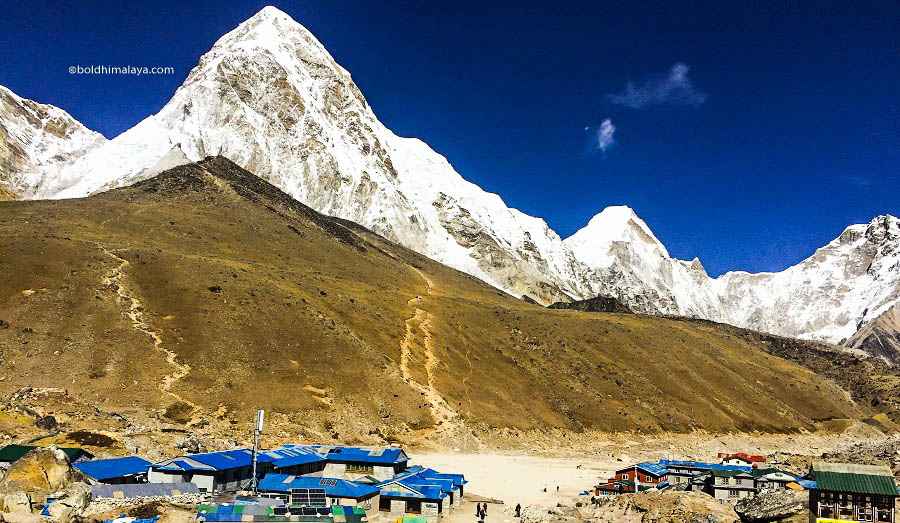
Everest Base Camp 11 Days Trek
Price on request
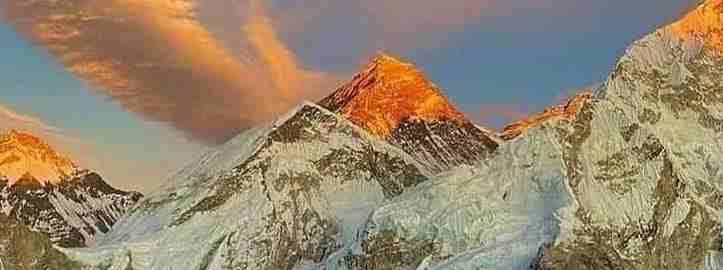
Everest Base Camp Trek 12 days
Price on request
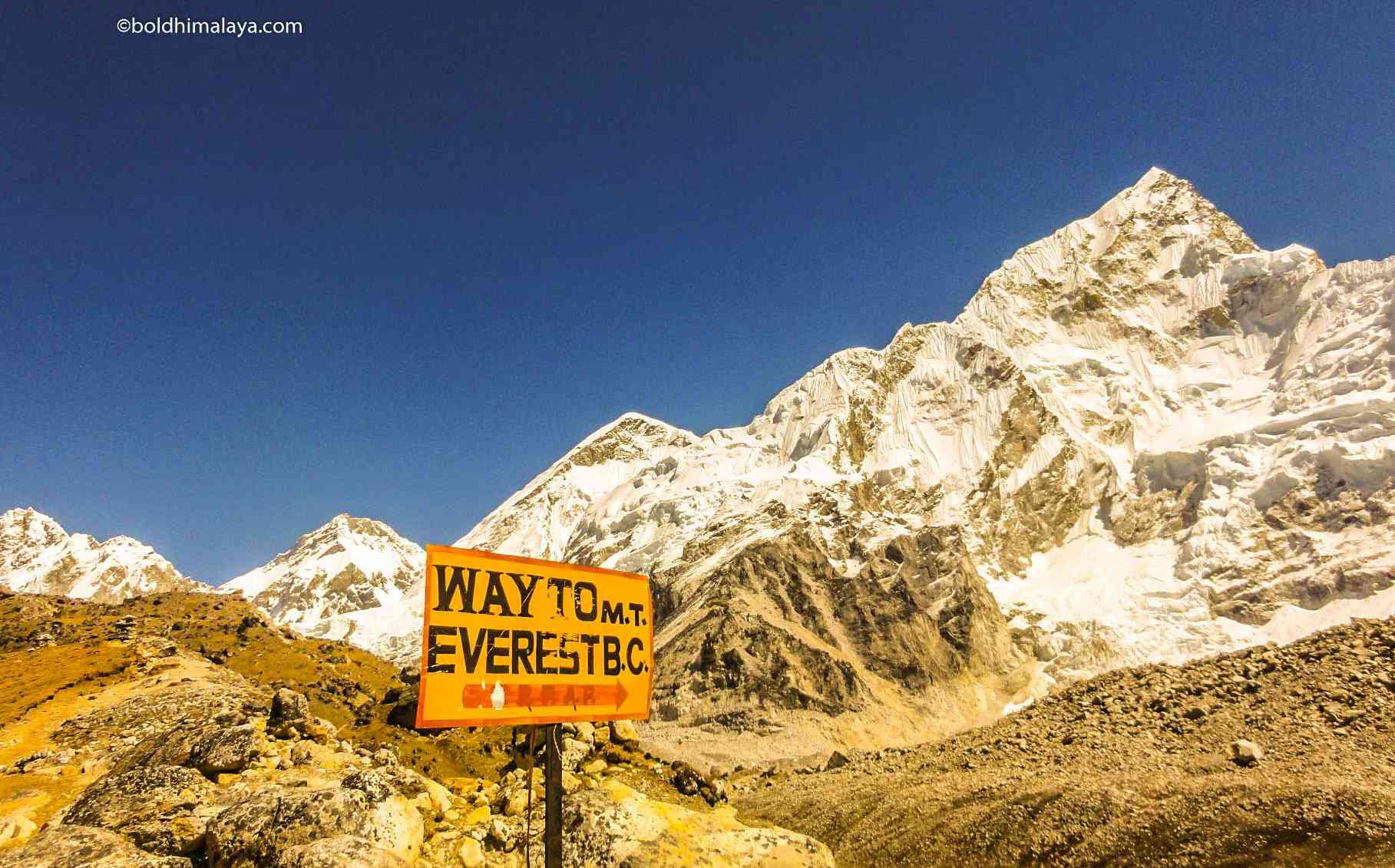
Everest Base Camp Trek 13 Days
Price on request
Glacier
The Everest region of Nepal is home to several large glaciers, which are an integral part of the landscape and play a vital role in the ecosystem of the region.
These glaciers are formed by the accumulation of snow and ice, and they are fed by the snowfall and glacial melt from the high Himalayas. These glaciers are important for the local communities as they provide water for irrigation, domestic use, and hydropower generation. Some important glaciers are
1. Khumbu Glacier

The Khumbu Glacier is one of the most well-known glaciers in the world, located in the Everest region. It is the largest glacier in the region and it is located at the base of Mount Everest. The glacier is approximately 15 kilometers (9.3 miles) long and 1 kilometer (0.6 miles) wide and it's the starting point for climbing Mount Everest and other peaks in the area. The Khumbu Glacier is fed by the snowfall and glacial melt from the high Himalayas and it's the source of the Dudh Kosi river, which is a major tributary of the Bhotekoshi River.
The Dudh Kosi river is an important source of water for the local communities, providing irrigation for the fields, and drinking water, and also it's a source of hydroelectric power. Climbing on the Khumbu Glacier is a challenging and strenuous experience that requires good physical condition, proper equipment, and acclimatization.
The glacier is constantly moving, and crevasses can open up unexpectedly, making it a dangerous place to be. It's important to be aware of the risks of falling into a crevasse and to follow the advice of local guides and mountaineers. The Khumbu Glacier is also home to the Khumbu Icefall, which is one of the most dangerous sections of the climb to Mount Everest.
It's a constantly shifting maze of ice towers and crevasses that can be difficult to navigate and prone to avalanches. The Khumbu Glacier, like other glaciers around the world, is melting rapidly due to the effects of global warming. The retreat of the glacier over the last century has been dramatic, and it's important to be aware of the impacts of climate change in the region and to work together to reduce the effects of this problem.
2. Imja Glacier
The Imja Glacier is a large glacier that is located in Imja valley, near the Everest area. It is about 5 kilometers (3 miles) long and 1 kilometer (0.6 miles) broad, and it is nourished by snowfall and glacier melt from the high Himalayas. It is the source of the Imja Khola river and one of the fastest-moving glaciers in the area.
Since the Imja Glacier is situated in the Imja valley, a stunning and isolated region noted for its different landscapes that range from subtropical woods to high-altitude deserts, it is also a well-liked destination for trekkers and mountaineers.
The Imja Tse Base Camp trek also referred to as the Imja valley trek offers a distinctive blend of natural and cultural experiences as it traverses traditional Sherpa villages, lush forests, and high-altitude deserts with breathtaking views of the Himalayas, including Mount Everest, Lhotse, and Ama Dablam.
Lakes
There are numerous high-altitude lakes in the Everest region, which constitute a prominent part of the scenery and are essential to the region's environment. These lakes, which are generated by glacial melt from the high Himalayas, are appreciated by trekkers and mountaineers as they give breathtaking views of the neighboring peaks and a different viewpoint of the Himalayas. one of the most important lakes in the Everest region include:
1. Cho La Lake
Cho La Lake is a high-altitude lake located in the Everest region. It is situated in the Khumbu region, near the Cho La pass, which is a popular trekking route that connects the villages of Dzongla and Gorak Shep. The lake is located at an altitude of 5,330 meters (17,490 feet) above sea level, and it's surrounded by spectacular mountain peaks, including Ama Dablam, Lobuche Peak, and Pheriche Peak.
The Cho La Lake is a glacial lake, which is formed by the glacial melt from the surrounding peaks, and it is known for its crystal clear waters and stunning scenery. The lake is a popular destination for trekkers and mountaineers, as it offers a unique perspective of the Himalayas and a sense of accomplishment for those who complete the trek.
Crossing the Cho La pass to reach the lake is a challenging experience that requires good physical condition, proper equipment, and acclimatization. The pass is steep and rocky, and trekkers must navigate through loose rock and scree. The views from the top of the pass are spectacular, with panoramic views of the Himalayas.
The Cho La Lake is also considered a sacred site by the local people, and it's important to be respectful of the local culture and customs when visiting the lake. The trek to the Cho La pass and the lake is considered more challenging than the classic Everest Base Camp trek, and it requires more time, effort, and experience. It's important to be aware of the risks of altitude sickness and to follow the advice of local guides and trek leaders.
2. Imja Lake
Imja Tsho (also known as Imja Lake) is a high-altitude glacial lake located in the Everest region. It is situated in the Imja valley, near the base of Mount Imja Tse (also known as Island Peak). The lake is formed by the retreat of the Imja Glacier and it's considered a relatively new lake that has formed in recent years. The lake is located at an altitude of 5,010 meters (16,434 feet) above sea level, and it's surrounded by spectacular mountain peaks, including Mount Everest, Lhotse, and Ama Dablam.

The Imja Tsho lake is considered a potential threat to the local communities as it's prone to glacial lake outburst floods, due to the melting of the Imja Glacier. The lake has grown rapidly in recent years, and it's being closely monitored by the local authorities, as the potential for a GLOF (glacial lake outburst flood) could cause significant damage to the local communities and infrastructure.
The Imja Tsho lake is also a popular destination for trekkers and mountaineers, as it is located in the Imja valley, which is a beautiful and remote area known for its diverse landscapes, which range from subtropical forests to high-altitude deserts. The Imja Tse Base Camp trek, also known as the Imja valley trek, offers a unique combination of natural and cultural experiences, as it passes through traditional Sherpa villages, lush forests, and high-altitude deserts, with stunning views of the Himalayas, including Mount Everest, Lhotse, and Ama Dablam.
It's important to note that visiting Imja Tsho lake is a challenging and strenuous activity that requires proper planning, preparation, and the guidance of experienced local guides. It's also important to be aware of the risks of altitude sickness and to follow the advice of local guides and trek leaders.
Flora and Fauna
The Everest region, located in Nepal, is home to a diverse array of flora and fauna. This includes a wide range of plants and animals that thrive in the unique and challenging conditions of the region. The Sagarmatha National Park, which is a UNESCO World Heritage site, is the highest national park in the world and encompasses most of the species of flora and fauna found in the region.
The plants and vegetation in the region are dependent on the time of year that one is visiting. Different species of plants bloom at different times throughout the year, making the region a constantly changing and dynamic landscape. The cash crops that are grown in the region include wheat, barley, corn, potatoes, and seasonal vegetables.
In the lower forest region, one can find forests filled with birch, juniper, pine, firs, bamboo, and rhododendron, whereas the higher altitude is home to lichens and mosses. Plants stop growing above an altitude of 5750m, as this is the permanent snow line in the Himalayas. After rainfall in June, the National Park and the entire region are decorated with different plant species. The flora found in the Everest region includes:
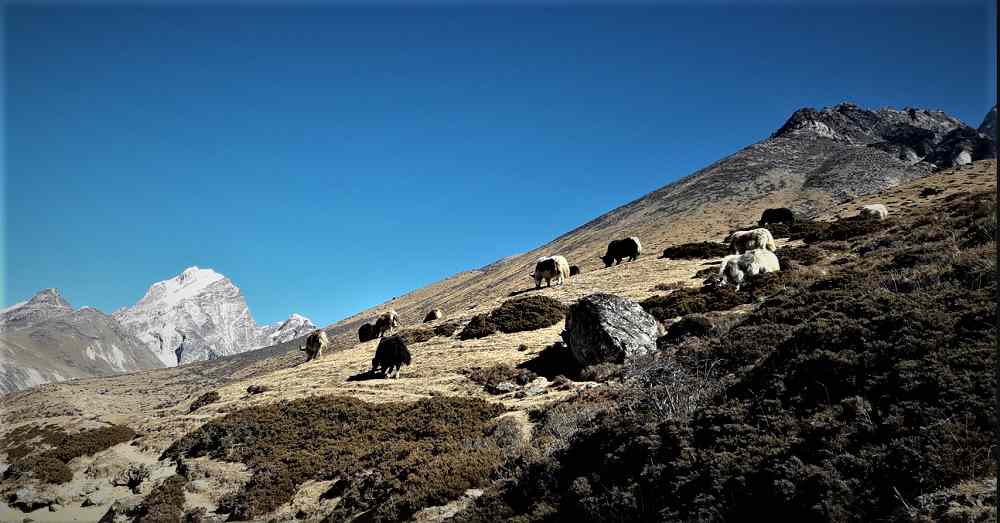
Tree Rhododendron aka Lali Gurans Barbed-Stalk Rhododendron Bell Rhododendron Curved-Fruit Rhododendron Three-Flowered Rhododendron Bristly Rhododendron Dwarf Snow Rhododendron Lily of the Valley Anemone Clematis Drumstick Primrose Kumaon Iris Himalayan Edelweiss Edelweiss Spiny Mountain Poppy Silky Rose The National Park is also a habitat for many endangered animals that live in the higher altitudes. These animals have adapted to the chilly weather of the region and can be found in the wild. Some of the animals that are found in the region include
Snow Leopard, Musk deer, wild yak, Himalayan black bear, and mountain fox. Additionally, yaks, buffaloes, goats, and pigs are some of the animals that are used for farming by the people of the region. The region also hosts numerous varieties of birds and other reptiles. Despite the diverse geographical distribution and climatic conditions of the region, the Everest region continues to surprise us with its beautiful and diverse flora and fauna.
However, maintaining the ecological balance is crucial to saving the endangered plants and animals of this region. Some of the fauna found in this region include: Snow Leopard Musk deer Wild yak Himalayan black bear Mountain fox Blue sheep Red panda Snow cock Pika Himalayan tahr
Mountains above 6000m
Mountains above 6000m
Mount Everest (8 848 m) Mount Lhotse (8 516 m) Cho Oyu (8201 m) Gyachung Kang (7952 m) Ngozumpa Kang I (7916 m) Nuptse I (7861 m) Numbur (6959 m) Chamlang (7319 m) Pumori (7184 m) Lunag Ri (6895 m) Taboche (6495 m) Angole (6906 m) Kangtega (6779 m) Ama Dablam (6856 m) Island Peak (6189m) Parchemuche Peak (6187m) Cholatse Peak (6440m) Kusum Kanguru Peak (6367m) Kwangde Ri Peak (6184m) Kyozo Ri Peak (6184m) Pachermo Peak (6273m) Thamserku Peak (6623m) Tabouche Peak (6542m)

Conclusion
In conclusion, the Mount Everest region is one of the most beautiful and culturally rich places in the world, and Bold Himalaya is the best company to help you explore it. With a wide range of travel options available, there's something for everyone. Whether you're looking for an adrenaline-pumping trek or hike, a cultural tour to explore the local customs and traditions, or an adventure activity, Bold Himalaya has got you covered.